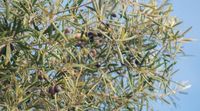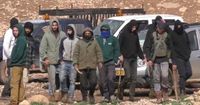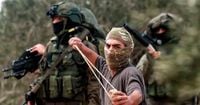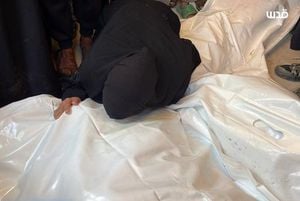On October 19, 2025, the olive groves of Turmus Ayya, a village northeast of Ramallah in the occupied West Bank, became the scene of yet another violent confrontation—one that would reverberate far beyond its terraced hills. U.S. journalist Jasper Nathaniel, covering the first day of the olive harvest, found himself at the center of a harrowing attack by Israeli settlers, an incident that has since ignited widespread outrage, fueled accusations of U.S. hypocrisy, and cast a harsh spotlight on the ongoing wave of settler violence in the region.
Nathaniel’s account, shared widely on X (formerly Twitter), described what he called an “ambush.” He had been documenting the harvest alongside Palestinian farmers, Swedish and Italian activists, and members of the International Solidarity Movement (ISM) when the Israeli military, ostensibly present to protect the farmers from settler attacks, led the group directly into the path of armed settlers. “These people need to be in prison by tomorrow, and the people of this village, and all across Palestine, need protection,” Nathaniel posted, along with footage of the attack.
The chaos that unfolded was captured on video: a mob of settlers chasing Nathaniel, smashing car windows as he sought refuge, and then turning their violence on an elderly Palestinian woman. She was clubbed to the ground, an act that quickly went viral online, prompting a torrent of condemnation. Among those injured were the elderly woman, a Swedish activist with ISM, and an Italian activist—all simply present to support the farmers during what should have been a peaceful harvest.
According to the United Nations Office for the Coordination of Humanitarian Affairs, this was just one of 71 incidents of Israeli settler violence against Palestinians and their property across the West Bank in a single week in October 2025. The scale and frequency of these attacks have escalated dramatically since October 7, 2023, as reported by Haaretz, with settler violence and illegal outpost expansion reaching levels not seen in years. The Judea and Samaria District Police, once responsible for maintaining order, have been described as “reduced to irrelevance.”
For the villagers of Turmus Ayya—and for many across the West Bank—such violence is not an aberration, but a daily reality. The ISM activist who tried to defend the elderly woman recounted, “I felt that I could not watch, and I decided to get the attention of the settler because otherwise I didn’t know what would happen to this woman. I got some minor injuries myself, but I really don’t think they can be compared to the injuries that Palestinians suffer every day that this occupation goes on just for living their life, just for existing.”
But the events in Turmus Ayya also drew attention to the role of the U.S. government—or, as many saw it, its absence. During the attack, Nathaniel reached out to the U.S. embassy in Israel for help. The embassy’s response, later shared by Nathaniel, was blunt: it could not provide protection, as safeguarding U.S. citizens in the occupied territories was the responsibility of the host nation, Israel. The exchange, which quickly circulated online, intensified scrutiny of U.S. policy and its relationship with Israel. “America can send Israel billions to continue a genocide but can’t protect one of its citizens from being almost murdered by a pack of armed settlers,” one social media user remarked, capturing the frustration felt by many.
The viral video and messages sparked a wave of commentary. Palestinian American Imam Omar Suleiman posted, “This picture of an Israeli settler tormenting a Palestinian farmer on her land captures so much about the daily routine of living under occupation for over 70 years. Unprovoked, unhinged, unseen by the American public, and entirely protected by the American government.” UN special rapporteur Francesca Albanese weighed in, questioning the silence of “decent” Israelis and calling for action against such violence.
Others pointed out the disparity in media coverage and diplomatic response. “If an American tourist was being chased and attacked by masked & armed government-backed terrorists in any country other than Israel, it would immediately become a major diplomatic crisis with wall to wall media coverage,” journalist Jeremy Loffredo noted. Palestinian-American political analyst Omar Baddar observed, “If there was an image of a Palestinian clubbing an elderly Israeli woman in the head and knocking her unconscious, it would be on EVERY SINGLE NETWORK as a main story. But the racist & often murderous brutality directed at Palestinians is deemed unworthy of attention.”
This incident is not isolated. Across the West Bank, dozens of Palestinian communities have been wiped off the map, while illegal settler outposts continue to proliferate. Since October 7, 2023, the phenomenon has only intensified, according to Haaretz. Large quantities of weapons have been distributed to settlers, who have carried out retaliatory raids while authorities stand by. Jewish settler violence goes unchecked, and so does the illegal construction of new outposts.
One stark example is the village of Khirbet Zanuta in the southern West Bank. Home to around 250 people, the community came under threat after the establishment of the Meitarim Farm outpost in 2021. For two years, residents endured threats and attacks. The message from settlers was chillingly clear: the violence would stop only if the villagers left. By the end of October 2023, just weeks after the war in Gaza began, the people of Khirbet Zanuta and the nearby community of Anizant were forced to abandon their homes. Once gone, settlers demolished village structures, fenced off the land, and the state prevented former residents from rebuilding.
Images of these erased communities, captured from the ground, the air, and satellite maps, are a stark testament to the transformation underway. The campaign of dispossession is relentless and, as Haaretz notes, there is little public discussion in Israel about ending it. Instead, the parallel campaign to the war in Gaza continues largely unchecked.
Some online commentators defended the U.S. embassy’s response to Nathaniel, arguing that, technically, the host country is responsible for the safety of foreign nationals. “I’m going to be real here; this is what I would have said if I was this ACS officer. Because it is, technically, true; the host country is responsible and diplomats aren’t bodyguards,” one user posted. But, as he pointed out, “the U.S. has unlimited leverage over Israel. Which it doesn’t use.”
Others reflected on the uncomfortable reality that such incidents only gain widespread attention when witnessed or experienced by Westerners. “I appreciate Jasper for helping our farmers, but it’s sad that Palestinian voices need validation from an American journalist to be believed,” one Palestinian social media user wrote. “Settler attacks happen almost daily, yet they only make news when filmed by an American.”
As the dust settles in Turmus Ayya and the ruins of Khirbet Zanuta, the questions linger. How long will this violence go unchecked? And who, if anyone, will step in to protect those living under its shadow?






